How to Share Your Google Drive
Google Drive is great for sharing all types of assets - spreadsheets, documents, pdfs, and folders, but can be really confusing when you’re trying to invite others to collaborate with you or share a file.
From the most basic level, there are two ways to share:
- Right click the file or folder from the list and click share
- Copy the URL of the file or folder and paste it in an email
But it gets more confusing from there:
Are you trying to share publicly (view only) or allow access to edit?
If you want the user to have edit access they need a Google account - is the email you are sharing connected to a Google account? Do they even have a Google account?
And, did you know there are actually two drives or drive concepts?
It can be really frustrating and unclear what the difference is.
There is a better way - a bit more info on that below 👇
But first, G Suite gives you access to two types of Google drives:
- My Drive - a personal drive and the only drive when using GSuite Basic
- Shared Drives - Shared drives for teams available on the more swanky G Suite plans
While you can share your files on both Google Drive types through email or with a link, what if you could share the same files with a custom link? Even better, a custom link on your own domain?
When you integrate your Google Drive with Content Camel, you get access to custom smart shortlinks and a lot of other features that G Suite does not offer.
You can create custom links for all your marketing and sales content with Content Camel and share them across all channels for a seamless customer experience. Plus, you’re getting to get real data on shares and views, so you can track the results 📈
Create Custom Shortlinks with Content Camel
Power up your Google Drive for marketing and salesDiving into all the detail on Drive sharing, here’s what we’ll cover:
My Drive vs. Shared Drive
My Drive is the personal drive of a user, which they use to access their own personal files.
This drive is accessible to all users for free as long as they have a Google account and it’s the only Drive option for all your users on GSuite Basic. It’s a convenient solution because you don’t have to go through the hassle of creating and managing another account just for the purpose of accessing Google Drive.
These could include:
- draft blog posts
- price lists
- battlecards
- confidential files
- meeting recordings
- videos
- monthly budgeting plans
- ebooks
- case studies
- and the list goes on.
Shared Drive on the other hand is only accessible when you have a full-blown business account with G-Suite (GSuite Business, GSuite Enterprise). Business plans are Business Starter, Business Standard, Business Plus. Enterprise accounts are Enterprise Essentials (Not to be confused with just Essentials!), Enterprise Standard, and Enterprise Plus. That’s a lot of plans 😜
A shared drive belongs to a team and allows different roles to be assigned to each team member, giving them specific control of the content within the drive.
Teams use the shared drives to collaborate and store all the content or files in a single storage platform to keep things organized. It allows users to be able to access and share any file anytime, anywhere.
The table below will help you get a quick overview of the difference between these two types of Google Drives.
| Questions | Google My Drive | Google Shared Drive |
|---|---|---|
| Who owns the files and folders? | The individual user of the drive | All the team members |
| Can I restore the files? | Yes | Only specific roles assigned to certain team members can restore the files. These are: • Administrator • Contributor • Content Manager |
| Can I move files and folders? | Yes | Following Roles can move files and folders: • File owners • Manager • Content Manager • Contributor |
| What are the sharing permissions? | The individual users can completely control who sees what file or folder in My Drive based on the access allowed. | Team members can view all the files and folders on the shared drive. They can share those files with people outside of the team, however, not all members can share folders. |
| Is it mobile-friendly? | Yes | Yes |
| How long do the deleted files stay in the trash? | 30 Days, Can be deleted earlier | 30 days. Members can delete them earlier |
| Who are the ideal Users? | • Individuals • Entrepreneurs • Non-profit Organizations • Startups |
• Startups • Established businesses • Enterprises |
| Is it free of cost? | Yes | No. (You need one of the Business G-Suite editions of Google Drive to create a shared drive.) |
Google Drive Sharing
When you’re sharing your files on Google Drive, you can adjust the access controls to:
- Editor
- Viewer
- Commenter
With whomever you share your file with, you need to decide the purpose of sharing in order to determine what kind of access they need. Once you know, you can quickly decide to share your file or folder.
With a seamless user interface and great accessibility for all types of users, sharing files on Google Drive is easier than it may seem.
They keep the user experience at the top of their priorities so that users of different ages can easily navigate through files and share them. It’s the reason why Google Drive is so popular with so many users.
To understand why Google Drive is so popular, it’s important to note that it’s built to work seamlessly with Google. And one of Drive’s best features is its integration with Google’s office suite of cloud-native apps, which, if you have experience with Microsoft Office, will look familiar.
It’s all about being familiar and comfortable with the experience that makes Google Drive as popular as it is.
Knowing that users share their files for multiple reasons, there are quick and easy ways to do that on both types of Google Drive. Read onward to find out.
Your Drive: Sharing files and folders
Step 1: Log in to your Google Drive
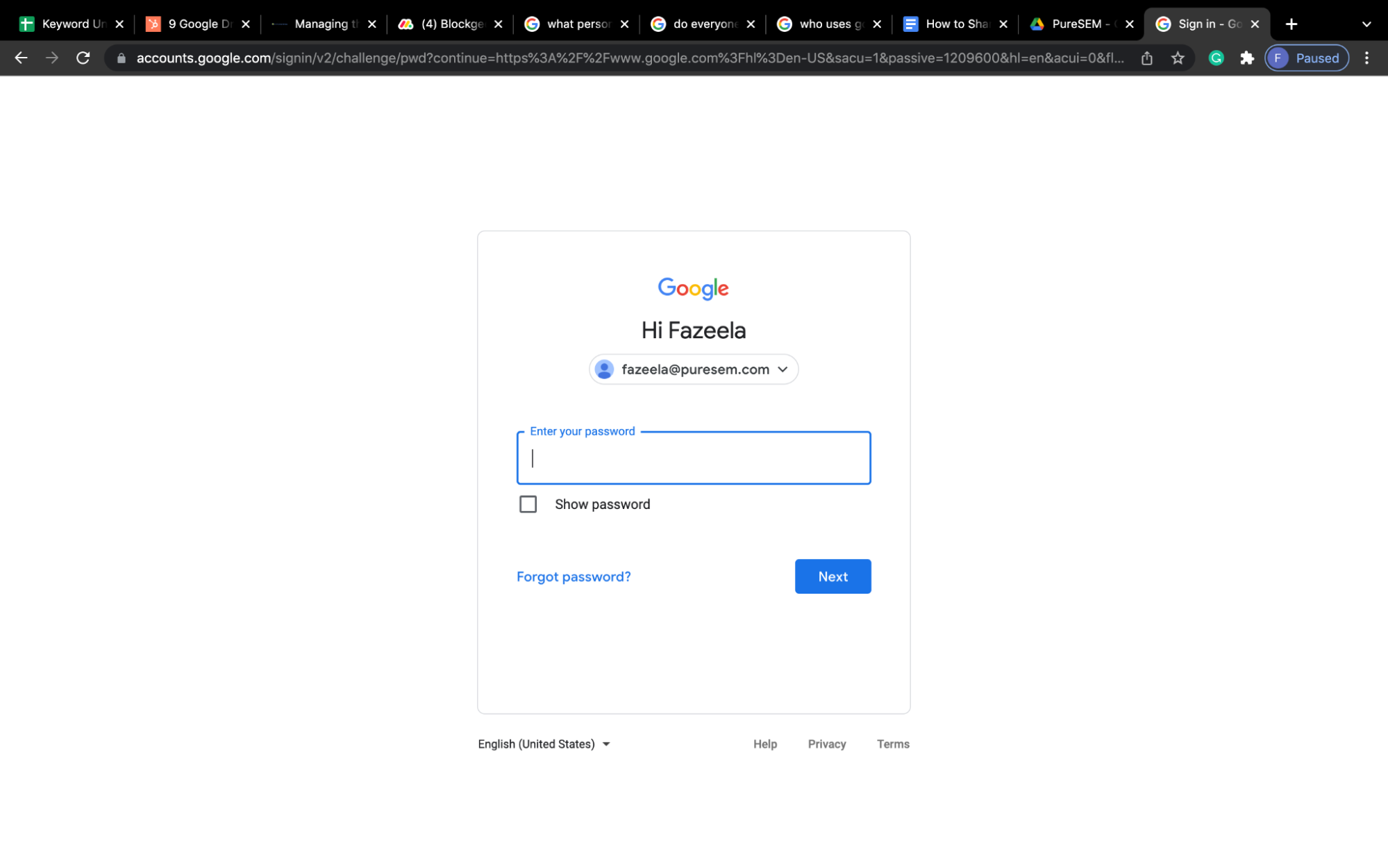
Step 2: Go to My Drive
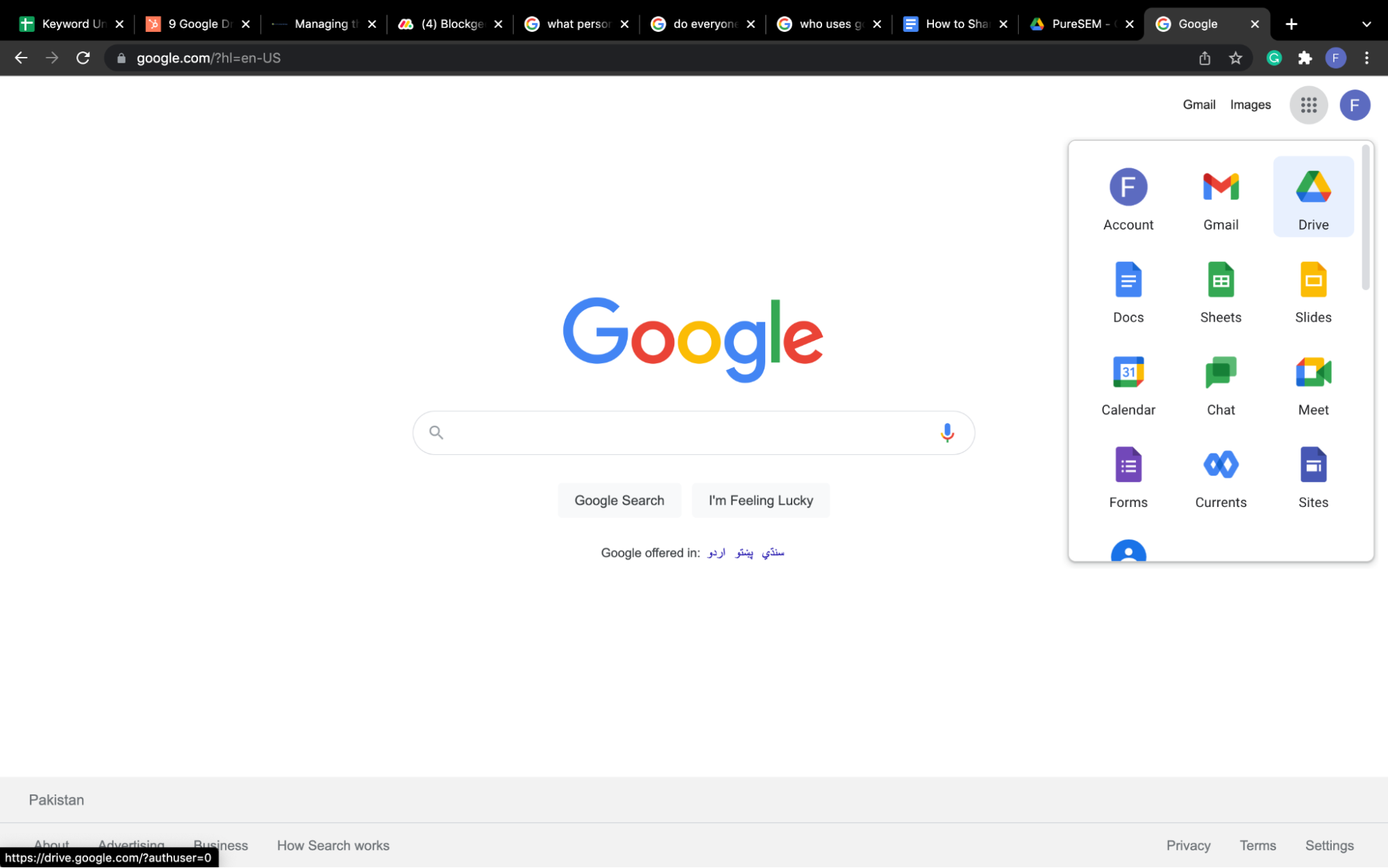
Step 3: Right Click on the file/folder you want to share and select Share from the drop-down menu.
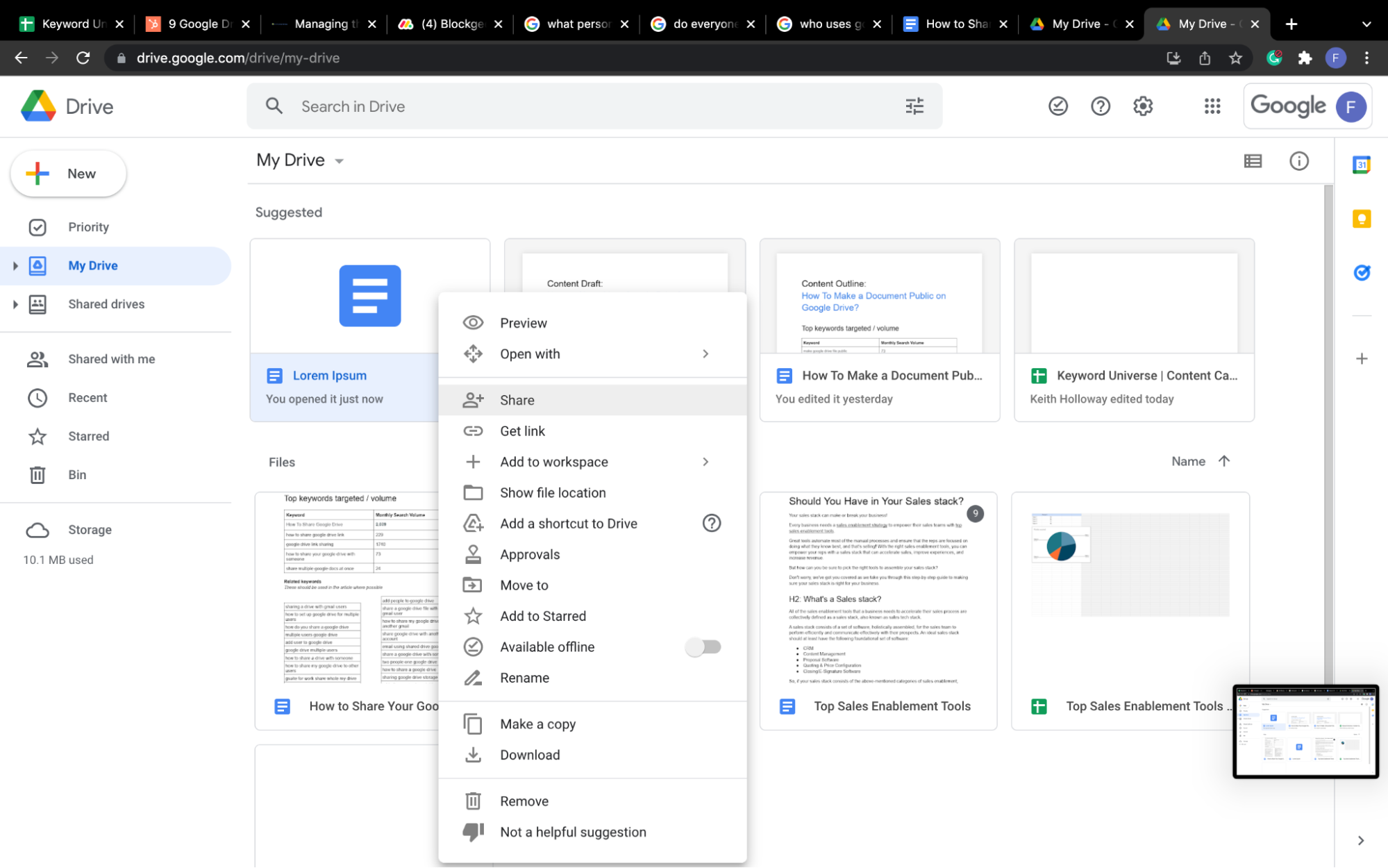
Step 4: Share through email
A text box will appear when you click Share. There you have two options to either share with email or share a link.
To share in email, simply enter the email address within the text box as illustrated in the screenshot below.
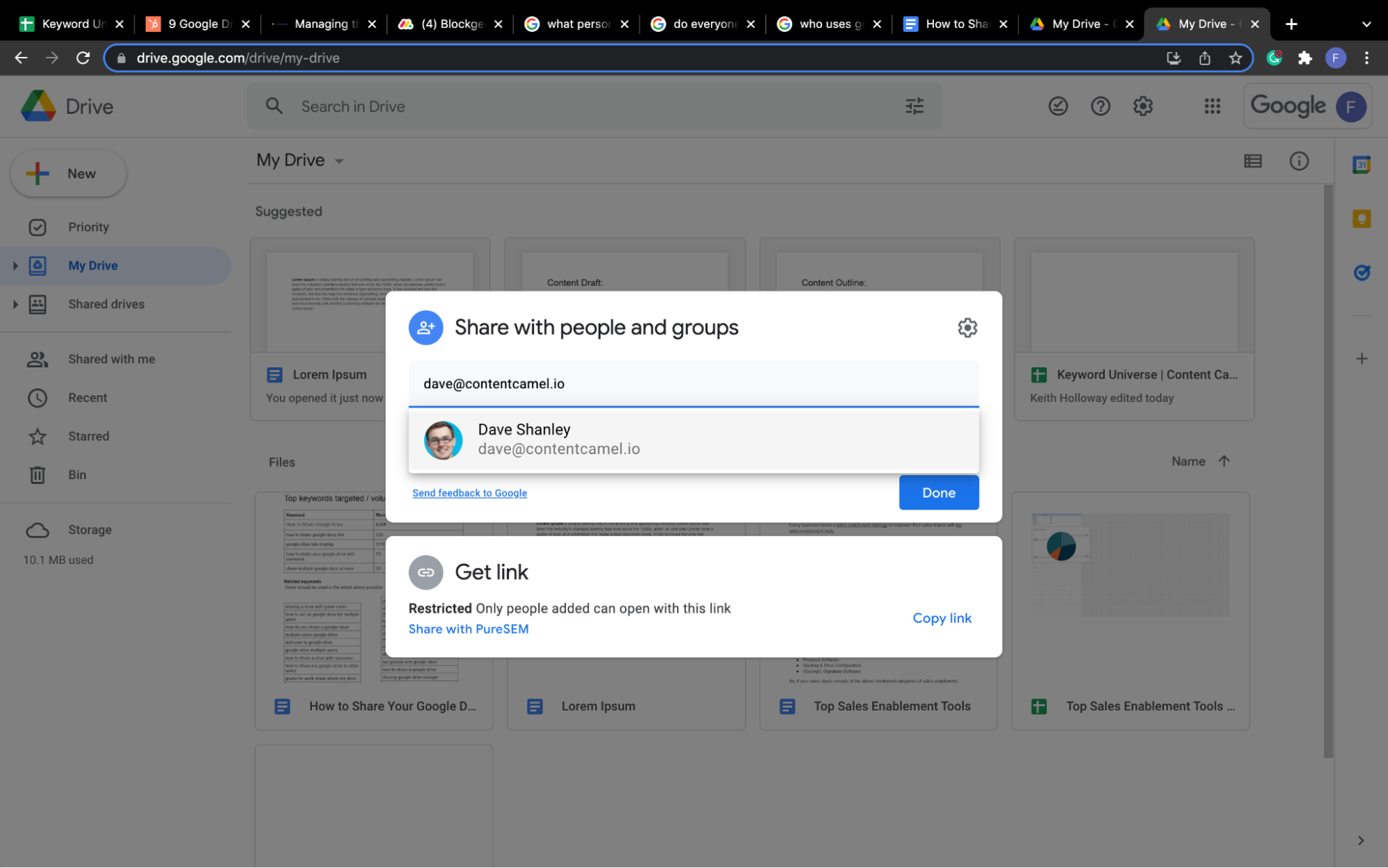
You can edit the access controls of the individual with whom you share the file by clicking the option on the right side, next to where you added the email address.

Once you’re done with that, click Send and the file is shared.
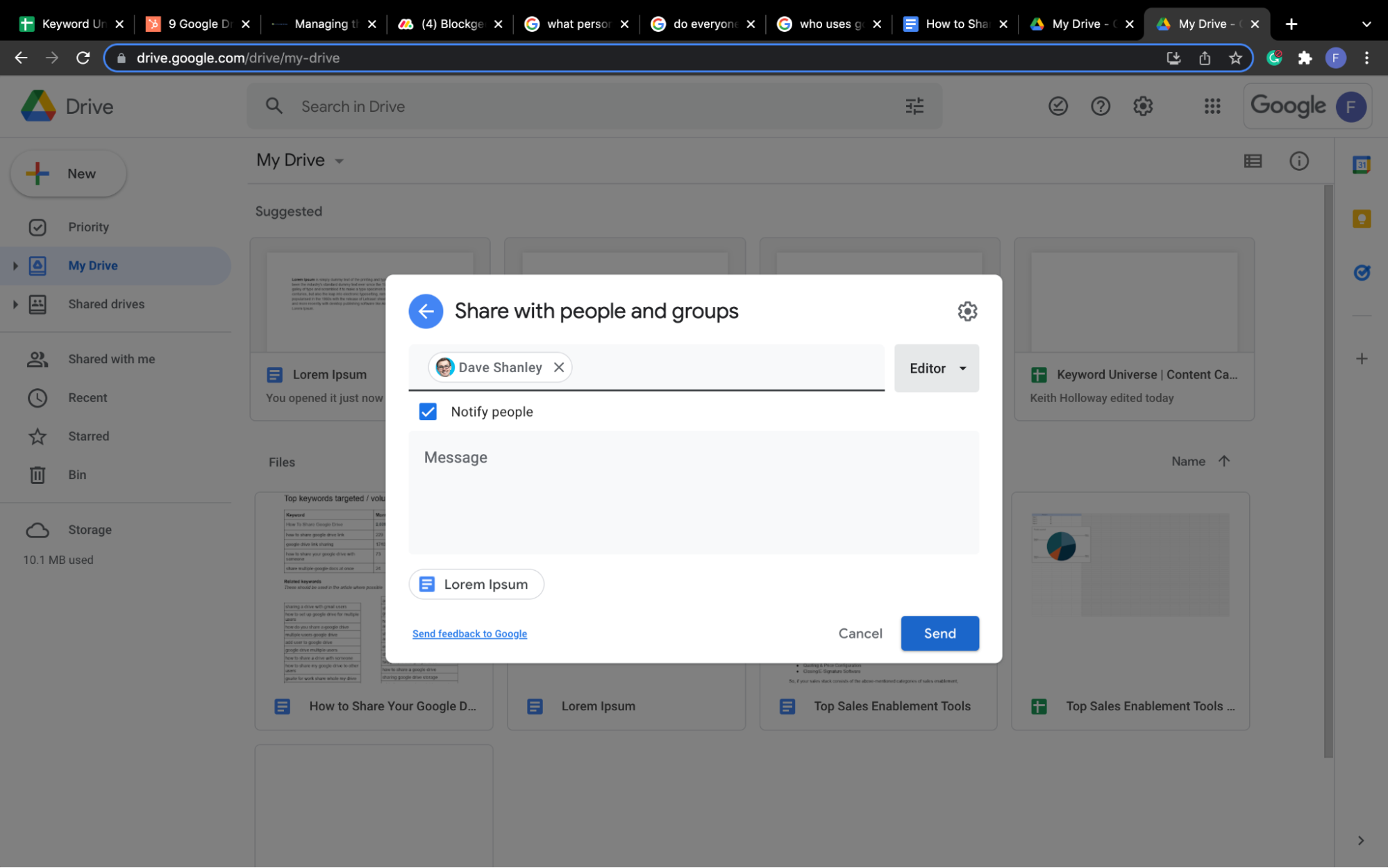
Step 5: Share with a Link
This is another quick way of sharing the file with anyone just by sending them a link to the file.
Once you remove the restricted option and switch to Anyone with the link, you can share your files with anyone, especially when you don’t have their email address.
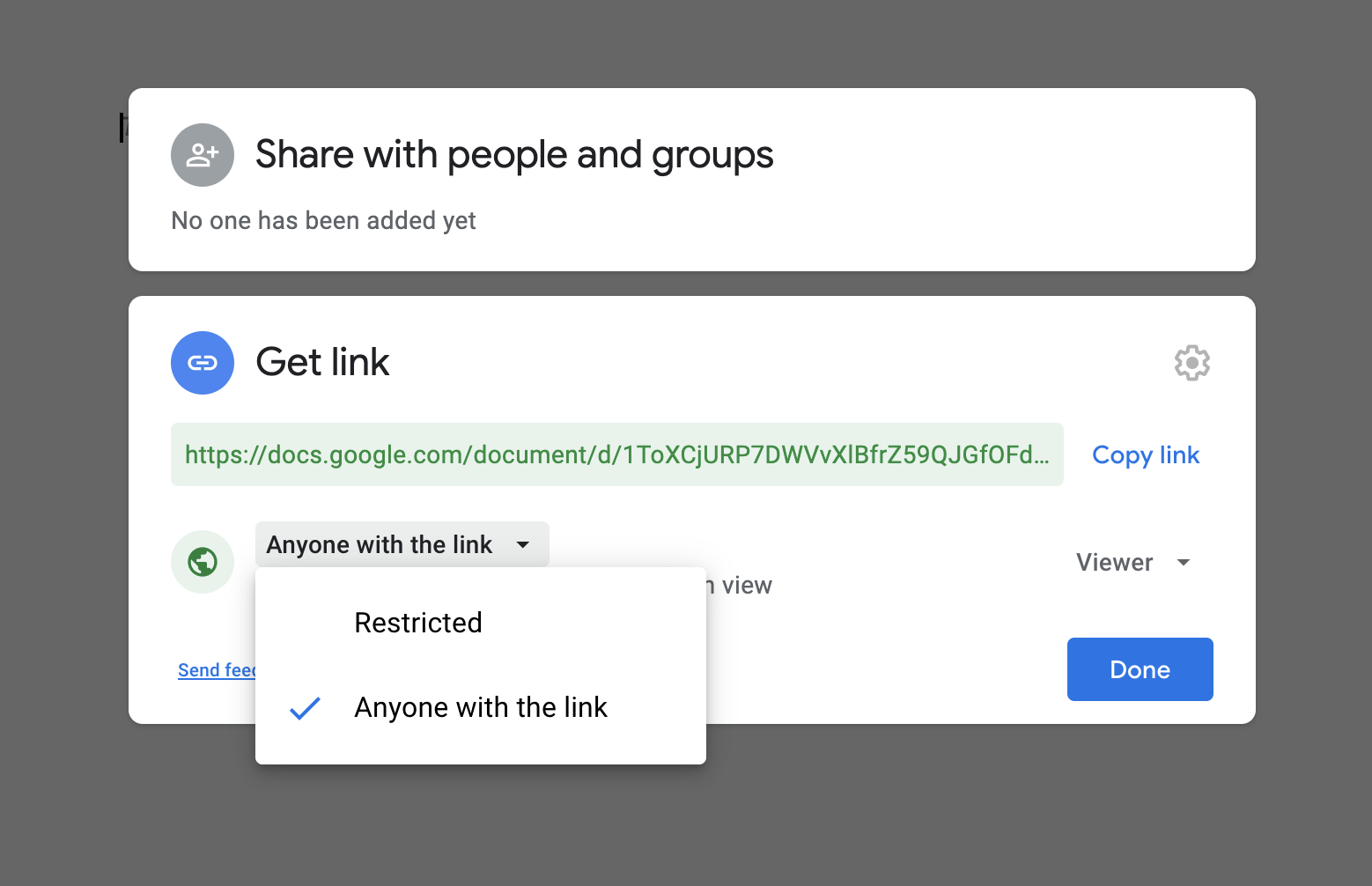
You can control their access to the file by restricting them as a viewer or a commenter. However, if you want them to edit your file then you can give them editor access anytime.
You can change these access controls anytime you want.

Once you’re done deciding that, you can simply copy the link and paste it where you want to share it.
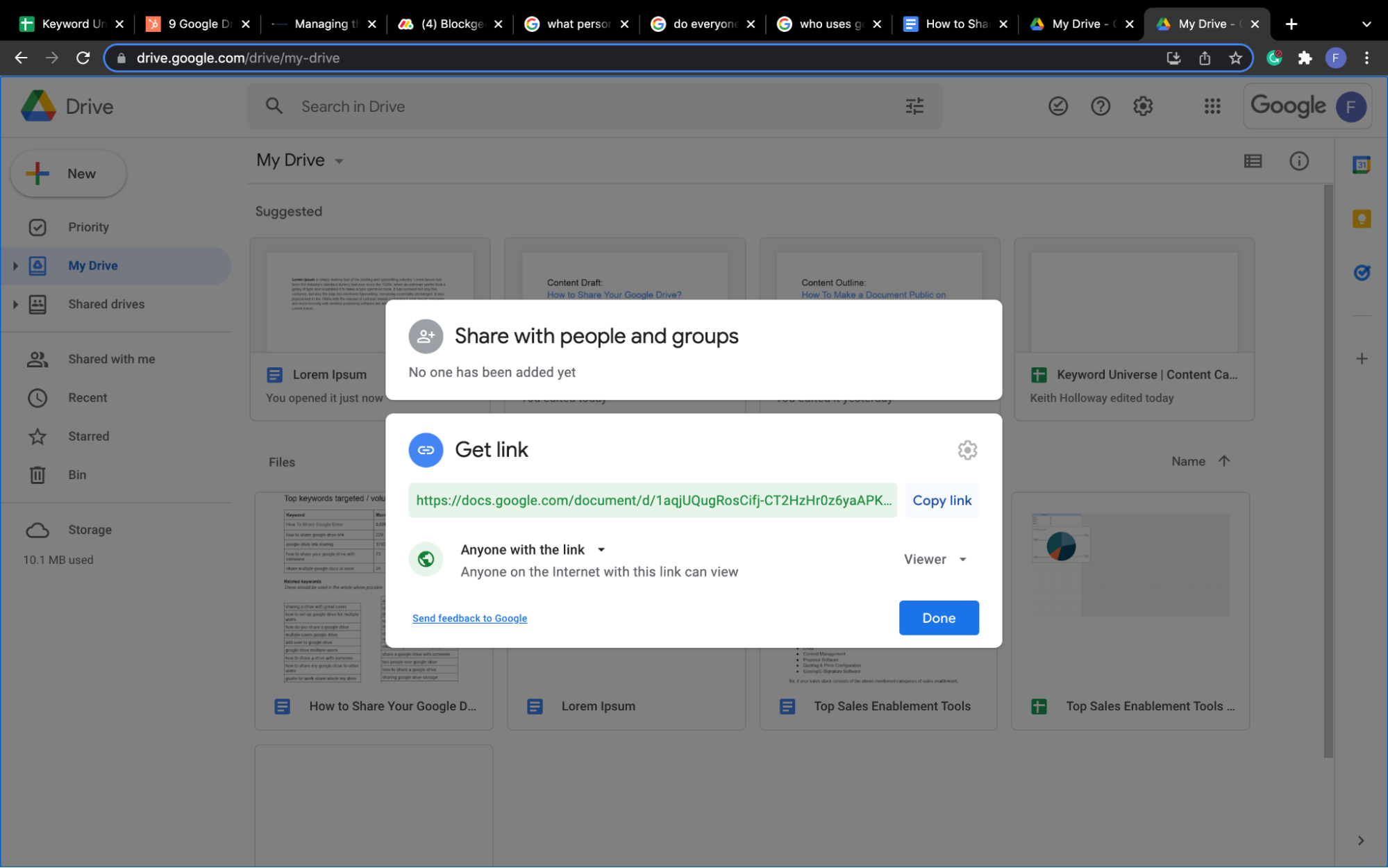
At the end click Done and you’re done.
Shared Drive: Sharing files
Step 1: Log in to Your Google Account

**Step 2: **Locate and Open Shared Drive
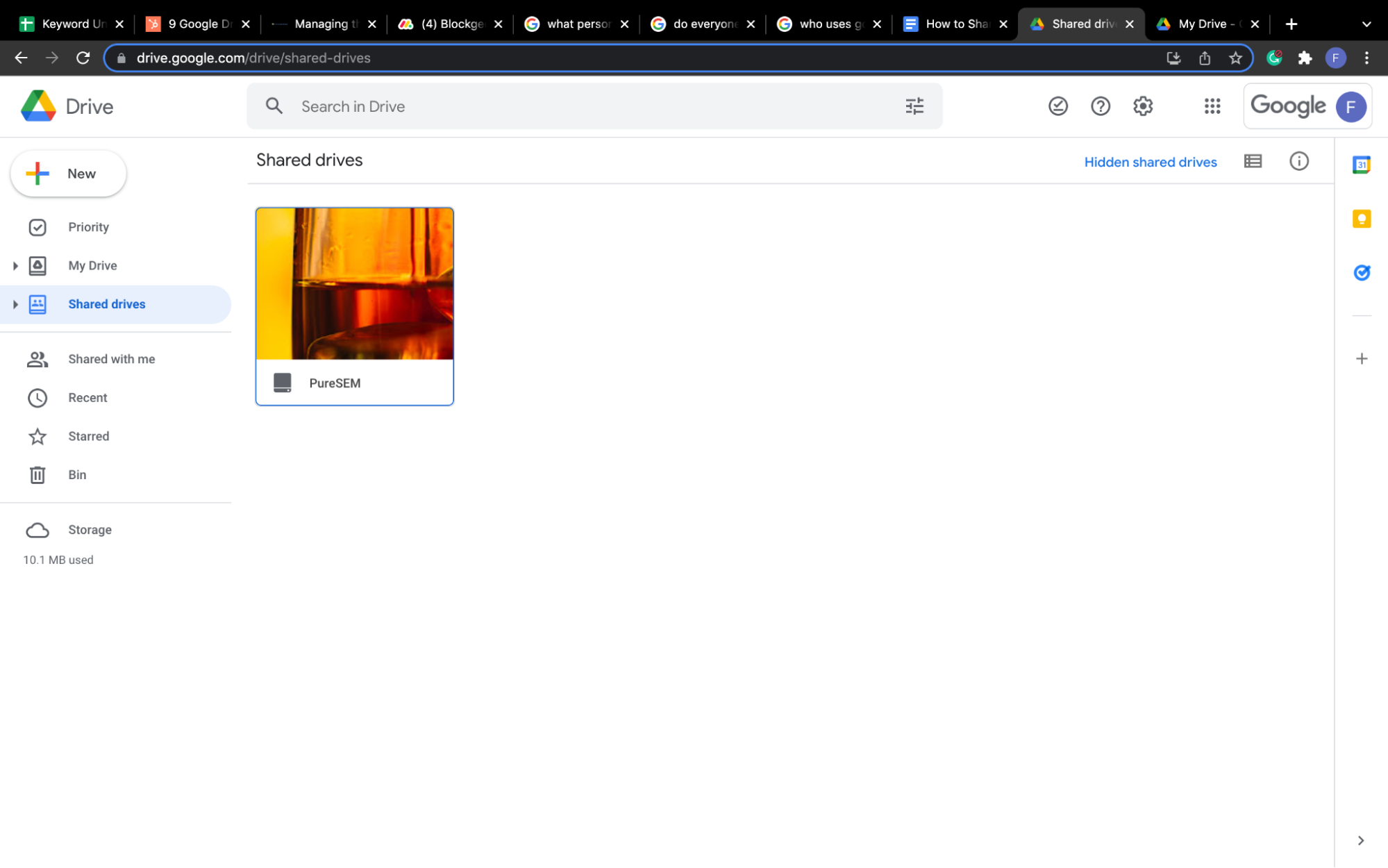
Step 3: Right-click on the file or folder you want to share and select Share from the drop-down menu.
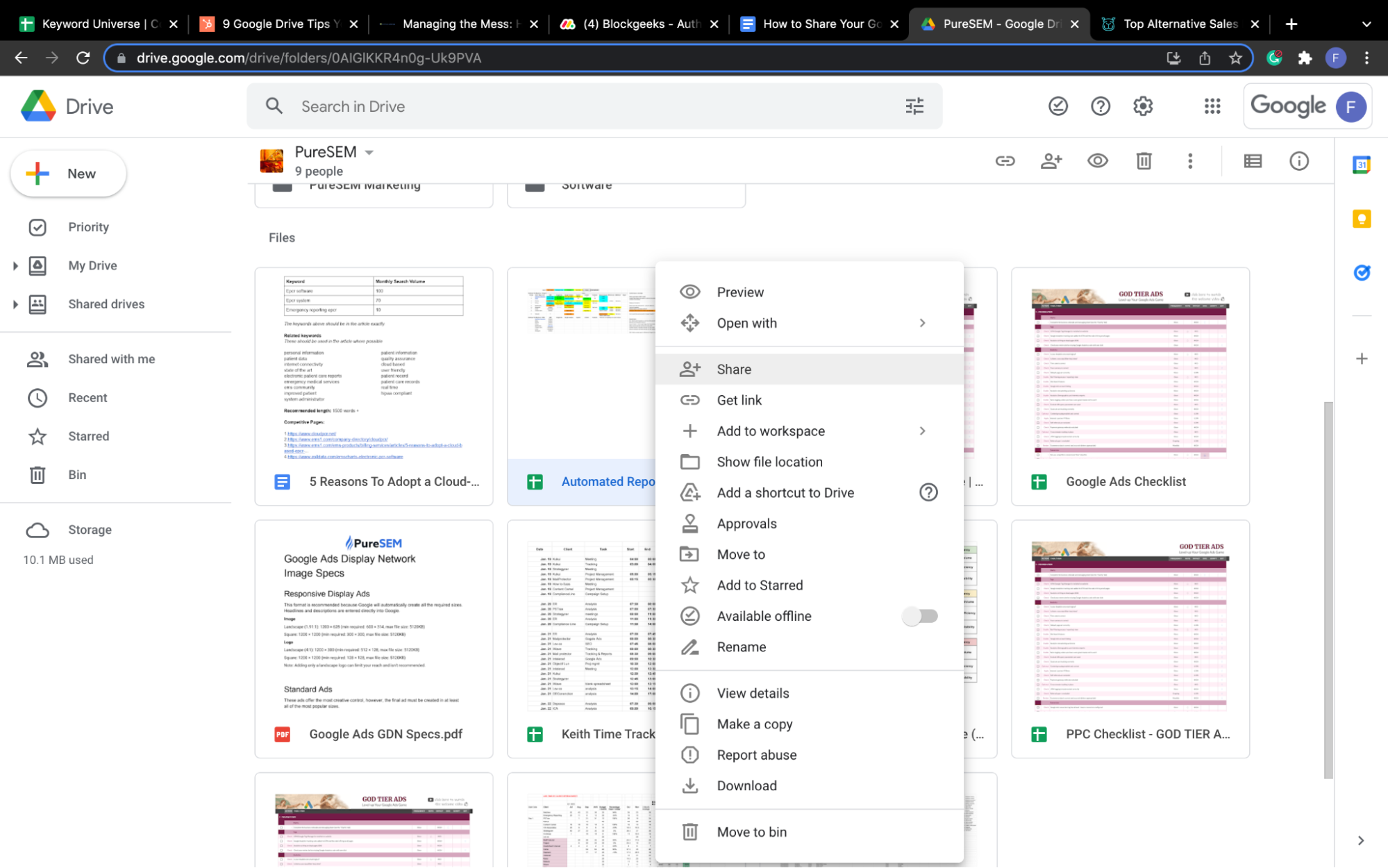
Step 4: Share through email
Enter the email address of anyone outside of the team to share the file.
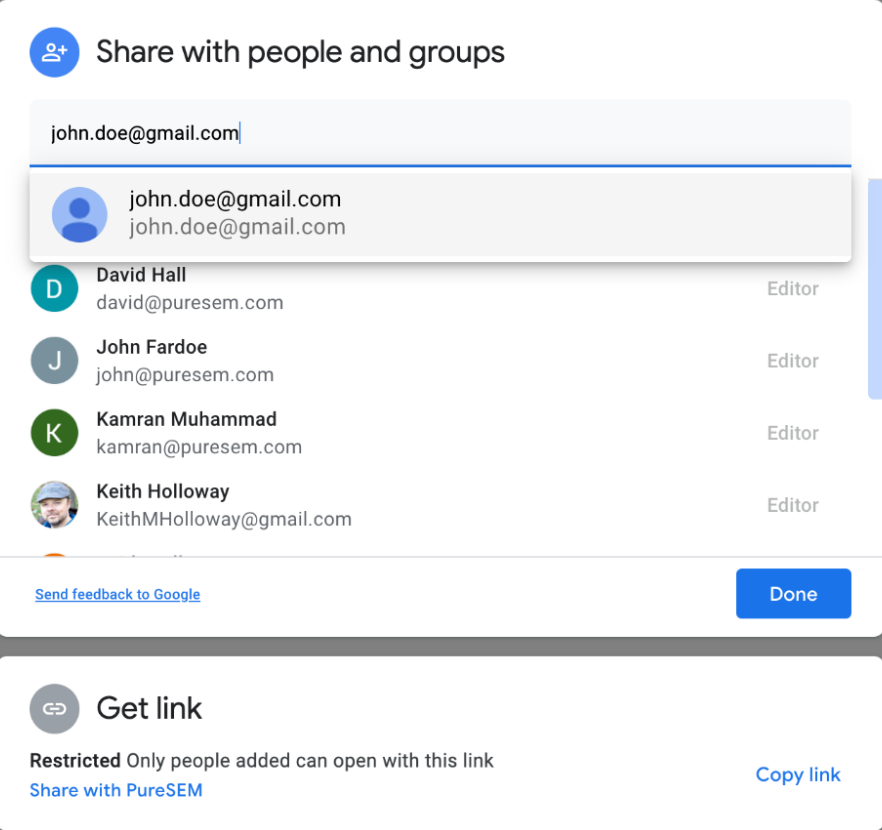
You can edit their access to the file as a viewer, commenter, or editor. Select whatever suits your intention.
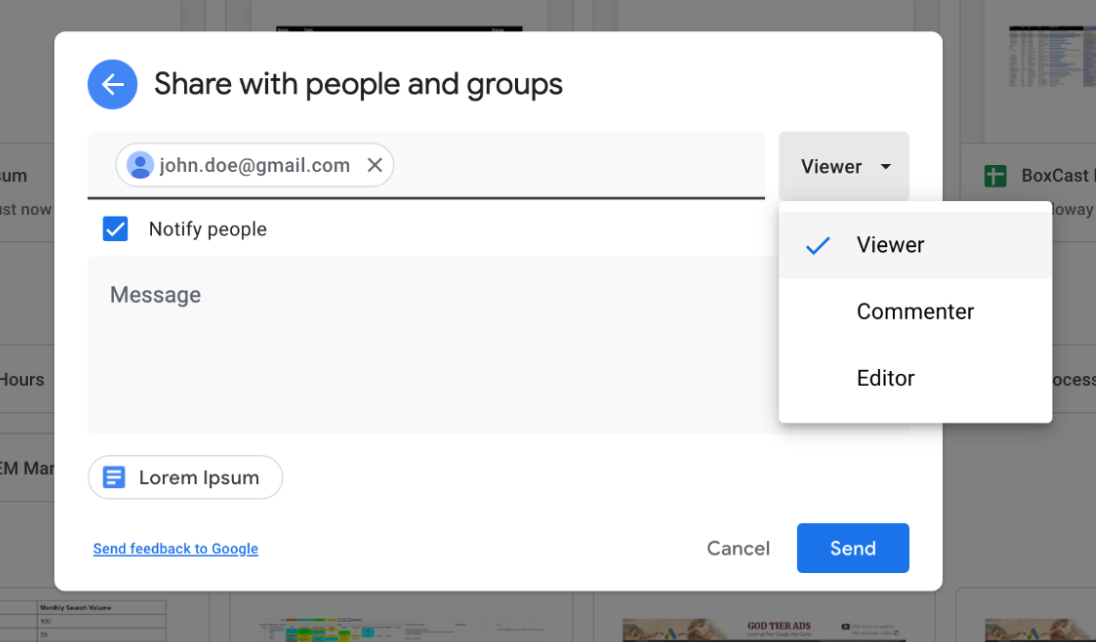
Click Send and you’ve successfully shared your file.
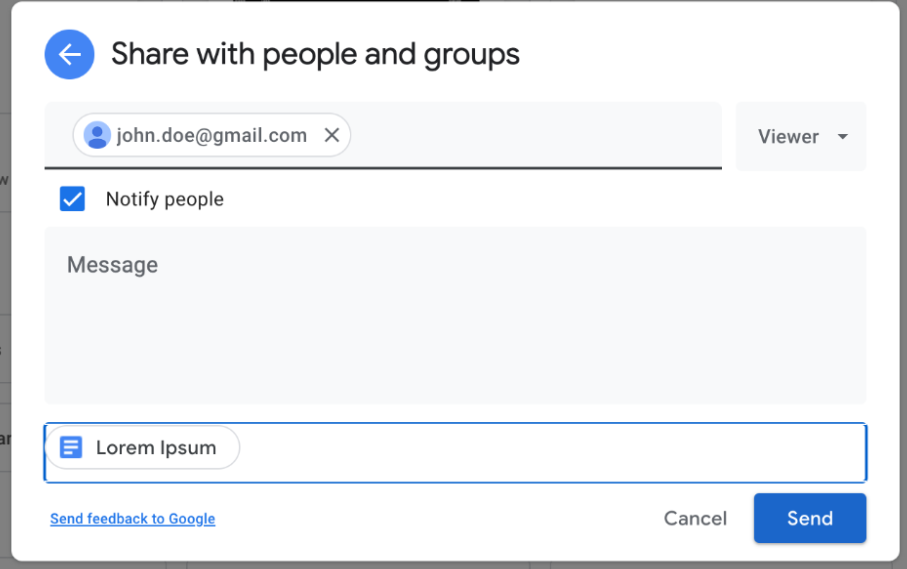
Step 5: Share with a Link
As you can share your file as a link in Your Drive, similarly you can share your files in the Shared Drive with a link. You can share this outside the team or within the team depending on the permission granted.
When you click Share as in Step 3, a text box will appear and if you look at the bottom of that text box, you’ll see something similar to the screenshot below.
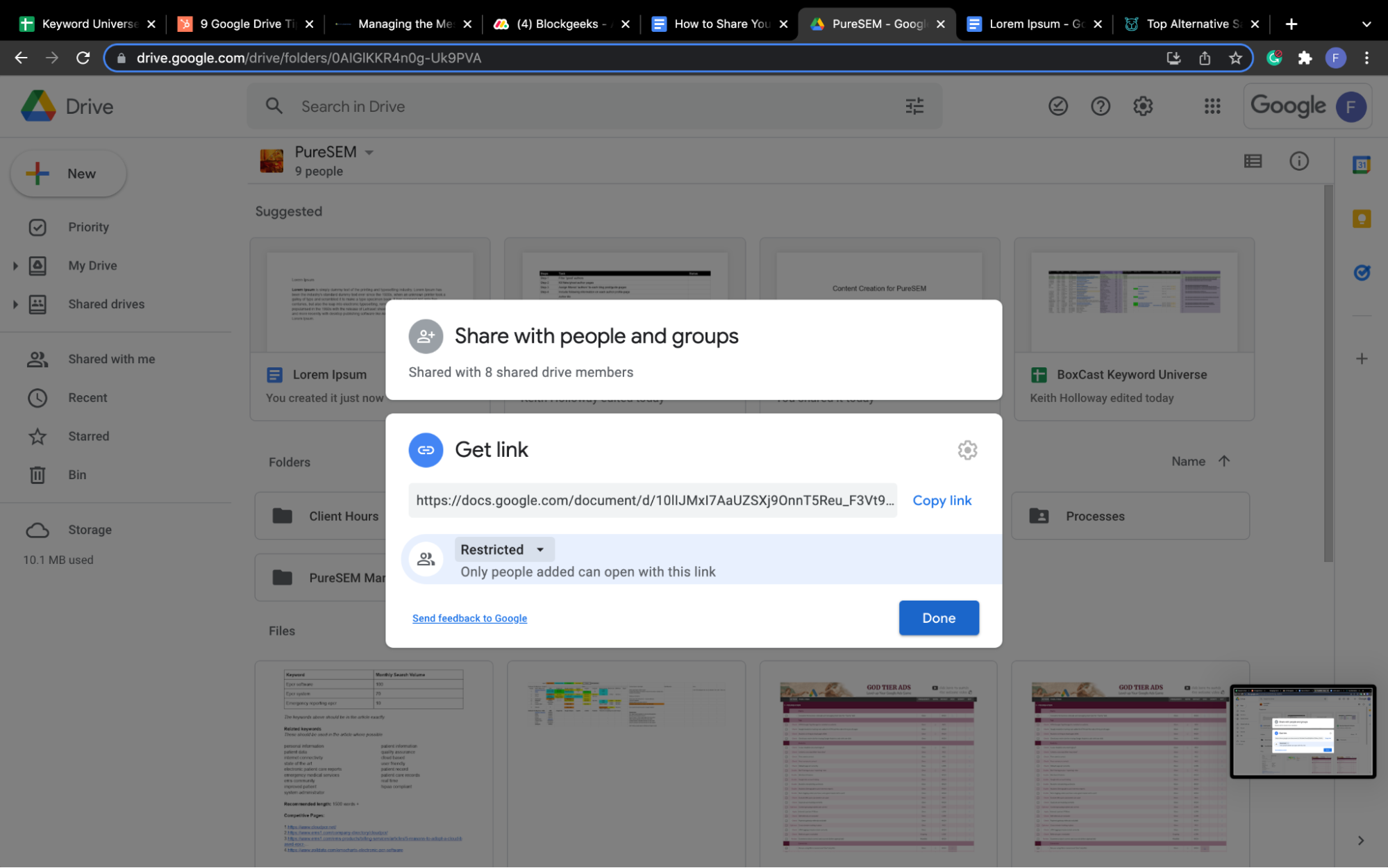
Click the arrow next to Restricted and you’ll get options to change your link access controls.
You can either share it with literally anyone or share it with all the members of the Shared Drive.
You can also make it Restricted and share it with a specific group of people through their email addresses.
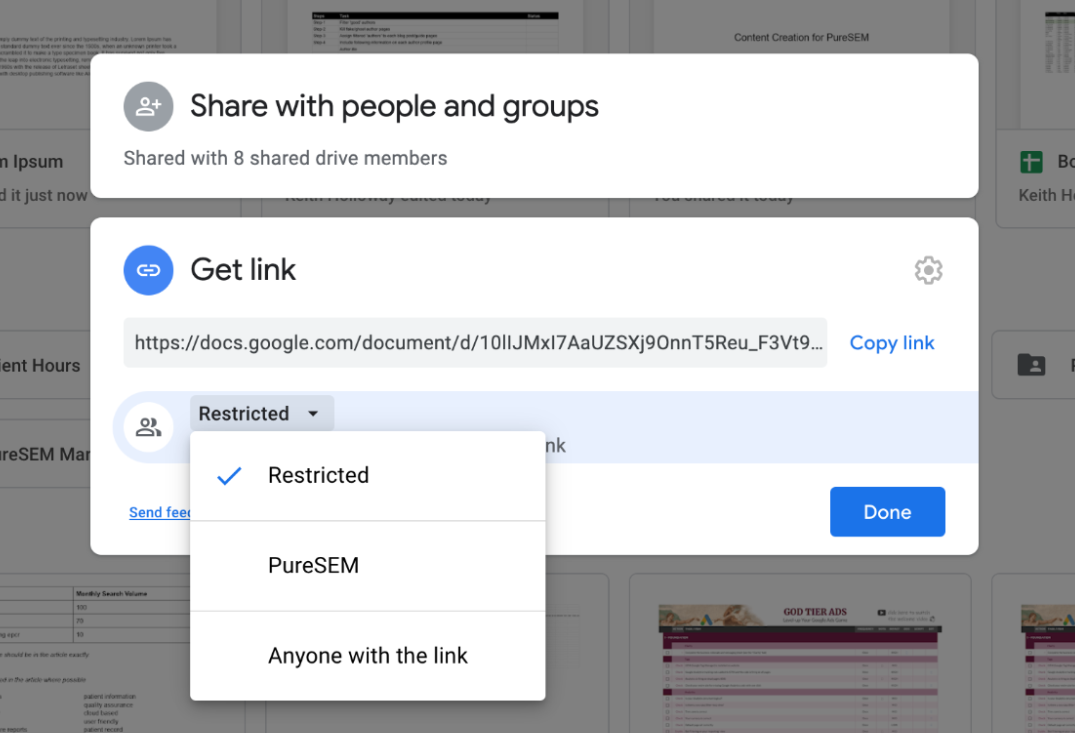
Once you’re done with deciding that, you can copy the link and paste it wherever you want to share the file.
Sales, Sales Enablement, and Google Drive
While Google Drive is being used by different people for all sorts of purposes, there are a ton of marketing and sales teams who are relying on Google Drive to store and share their high value content.
They can create sales content online or offline, and directly engage with their customers by sharing sales content with them.
They can create a shared drive to store all their content to make it available across the team at any time. When one seller needs something, they can instantly access it.
However, as the sales team grows and sales increase, the content grows with it. It could possibly become a disorganized mess with folders on top of each other, containing one version of the file and the other version in some other folder.
It becomes an overwhelming mess for sellers to deal with, which is why there are tools designed specifically for sales to better organize and manage their sales content.
Many sellers resist migrating to a new tool due to concerns with data transfer, onboarding, and more What can sellers do to transform their sales content management without leaving Google Drive?
In such a case, you need a specific sales content management tool that integrates with your Google Drive like Content Camel.
Designed specifically for proactive sales teams, Content Camel helps sellers to efficiently handle their sales content across all channels.
You can integrate your Google Drive with Content Camel, so you don’t need to worry about migrating data away or getting used to a new and unfamiliar system.
Your Marketing and Sales Team Need More
Once you integrate your Google Drive with Content Camel, you can access all your content on the Content Camel dashboard, organized into funnel stages aligned with your marketing and sales process.
It’ll help you access all of your content and make it available to all of your sales reps with the help of its powerful search features including advanced filters, custom tags, custom smart short links, and much more.
Explore Content Camel to learn more!
Content Camel helps you organize your sales content into different funnel stages and gives you insights on which content is popular and which is dead in the water.
These insights help you determine which piece of content you need to double down on and which you need to improve. It can also help to inform your overall content creation process going forward based on new patterns and strategies that you discover.
These valuable analytics help sellers determine their performance and create winning sales content.
As discussed earlier, when you’re sharing links for your Google files, you’re stuck with the auto-generated long URL.
With Content Camel, however, you get an option to either get a custom short link or configure your short links to your own custom domain where you house your assets
When you’re sharing such custom links with your prospects or customers, you’re giving them a visually trustworthy experience while engaging with your business.
Smart links can provide a sense of familiarity and intimacy between the seller and prospect due to their unique nature, and they also present a great opportunity for branding with custom URLs.
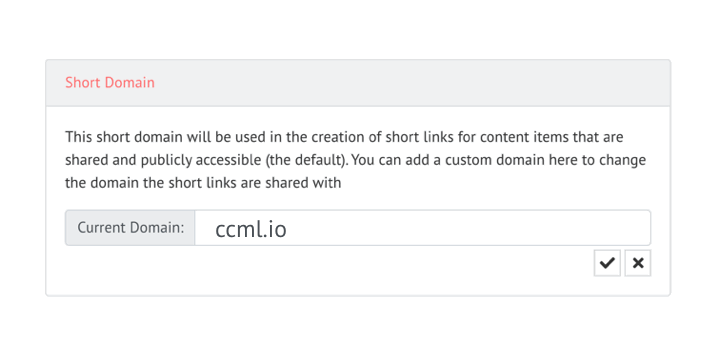
And since Content Camel offers a free version, you can always sign up and make your own decision!


